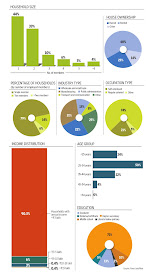The heterogeneity that characterizes the modern Indian consumer has created a maze that marketers would like to unravel in order to target their products and services precisely. In this fortnightly series, Indicus Analytics presents the various facets of urban consumers, across geographies and socio-economic groups.
The categorization of consumers by life stage and socio-economic classification (SEC) of the chief wage earners of households creates small segments with definite characteristics. There are around 1.2 million households in urban India India
 Households with chief wage earners in their younger years form a little more than 10% of this segment and household sizes are for most part small--three-quarters of the households in this segment have just one or two members. Given the low educational profile, small household size and the fact that the chief wage earner is on the early steps of the career ladder, house- hold incomes are usually less than `3 lakh per annum. There are only a few house- holds where income exceeds `10 lakh per annum and these are concentrated in Mumbai,
Households with chief wage earners in their younger years form a little more than 10% of this segment and household sizes are for most part small--three-quarters of the households in this segment have just one or two members. Given the low educational profile, small household size and the fact that the chief wage earner is on the early steps of the career ladder, house- hold incomes are usually less than `3 lakh per annum. There are only a few house- holds where income exceeds `10 lakh per annum and these are concentrated in Mumbai, Though the chief wage earners are mostly those who have finished higher secondary school, there are some who have attended college for basic degrees as well. Most of the skilled workers in India
The majority of chief wage earners have regular salaried jobs, less than a quarter have struck it out on their own. It is, of course, in smaller towns that the share of self-employed is larger than in cities, where jobs are more easily had. Around 20% of the chief wage earners have jobs in government or large private companies, indicating the opportunities available for those with skills. The main sector for employment here is manufacturing, followed by trade, public administration and trans- port and communication.
In this segment, households with senior citizens are very few and would be joint families; the consumption pattern would therefore be dictated by the chief wage earner who would be saving for a large family when children arrive on the scene.
Most of the households live in rented houses and penetration of consumer durables is also low for high-ticket goods such as cars and microwaves.
Most of the households live in rented houses and penetration of consumer durables is also low for high-ticket goods such as cars and microwaves.
These households first pick up two- wheelers and, of course, TV sets are al- most ubiquitous in urban households. Naturally, media penetration is highest through TV, and, interestingly, time spent on the Internet is more than on newspapers, with the radio coming a distant third. The presence of Internet cafes in all small towns and every locality of large metros is a pointer to this demand coming in from the younger set, who surf the Net for entertainment, news and jobs.
Another highlight of the consumer durable demand is that two-wheeler penetration is highest in the smallest towns, where public transport may not be a good and convenient option. Towns such as Erode, Hisar, Dibrugarh and Rajkot India

